Classified Spatial Clustering and Influencing Factors of New Retail Stores: A Case Study of Freshippo in Shanghai
Abstract
:1. Introduction
2. Materials and Methods
2.1. Study Area
2.2. Research Object
2.3. Research Methods
2.3.1. GIS Technology
- 1.
- Kernel Density Estimation
- 2.
- Clustering and Outlier Analysis
2.3.2. Radar Chart Analysis
2.3.3. Geographical Detector
2.4. Data
- The data of the research subject mainly come from the continuous tracking research conducted by the research team on the new retail industry in Shanghai from 2016 to 2022. We obtained information on store locations, target consumer groups, types, product categories, delivery ranges, and operating models from the website provided by Freshippo. After verifying the information for each store through a survey, we converted it into the data required for this study using ArcGIS 10.8 and Excel 2021 software (see https://www.freshippo.com/, accessed on 1 January 2023);
- Economic and social development data of districts and counties were obtained by compiling government announcements, statistical bureaus, “Shanghai Statistical Yearbook”, and other materials. The data released by the government are usually collected through rigorous review and statistical methods, ensuring high authority and reliability. These data provide a reliable, comprehensive, timely, and comparable foundation for scientific research, facilitating in-depth and valuable studies (see https://tjj.sh.gov.cn/, accessed on 10 January 2023);
- High-resolution satellite remote sensing imagery data can capture the geographical features and human activities in the Shanghai urban area in detail. They reflect the city’s vitality and economic activities through nighttime brightness, providing significant multipurpose value in supporting urban planning, environmental monitoring, and socio-economic analysis. Therefore, we obtained raw remote sensing imagery data from the Luojia-1 satellite website, which, after processing with RS and GIS technologies, serves as one of the key supporting data sources for this research project (http://59.175.109.173:8888/app/login.html, accessed on 10 January 2023);
- Compared to government bulletins and statistical data, POIs (points of interest) offers advantages such as a large sample size, diversity, and real-time updates, and it has been widely used by many scholars in urban studies. Consequently, in January 2023, we used Python to collect spatial attribute data on various types of facilities in Shanghai from the Amap website, including public infrastructure, healthcare facilities, hotel services, and life services (https://lbs.amap.com/, accessed on 10 February 2023);
- Vector data of administrative boundaries, roads, rivers, etc. in Shanghai were downloaded from the National Platform for Common GeoSpatial Information Services (https://www.tianditu.gov.cn/, accessed on 20 January 2023).
3. Results
3.1. The Changes in the Number of Stores
3.1.1. Changes in the Number of Different Types of Stores
- Overall, there is a growing trend in the number of Freshippo stores. The first store was opened in 2016, and by 2022, through investments in funds, technology, and personnel, the number had reached 450. This trend underscores Freshippo’s gradual expansion in Shanghai;
- Significant differences exist in the number of Freshippo stores among different types. Between 2016 to 2021, Freshippo fresh stores consistently had the highest number of stores, increasing from one store to 51 stores. The growth rate of Freshippo stores has been gradually slowing. With the opening of new stores and the transformation in service strategies of other types of stores, the number of Freshippo outlet stores has also increased. However, during this period, the number of Freshippo x membership stores, which primarily serve members, has remained relatively low. In 2022, Freshippo neighborhood stores were introduced as a new retail format, with 367 stores opening in Shanghai. Compared to the years 2016–2019, during the spread of the COVID-19 pandemic, concerns among investors and operators about investment risks may have contributed to the relatively slowed growth in the number of Freshippo stores, including Freshippo and Freshippo mini stores, in 2020 and 2021;
- From 2016 to 2021, only Freshippo fresh and Freshippo x membership stores in Shanghai offered online retail functions. In 2022, with the introduction of Freshippo neighborhood stores across Shanghai, a retail model that combines online retail services and consumer self-pickup was implemented, further bridging the service gap between online and offline retail. Concurrently, the proportion of stores equipped with online retail capabilities increased significantly, reaching 94%.
3.1.2. Changes in the Number of Stores in Each District
- The distribution of Freshippo stores across the urban central districts, urban periphery areas, and outer suburban districts shows dynamic and significant imbalances. From 2016 to 2021, the number of Freshippo stores in the urban periphery areas consistently exceeded that in the outer suburban districts, while the urban central district maintained a moderate number of stores. However, in 2022, the urban central districts had the fewest Freshippo stores, with the urban periphery areas and outer suburban districts having 6.86 and 4.27 times the number of stores in the urban central districts, respectively. The changes observed in 2022 reflect a strategic shift in Freshippo’s expansion efforts, placing greater emphasis on the urban periphery areas and outer suburban districts while reducing its presence in the urban central districts. This strategic pivot might stem from evolving market demands or Freshippo’s enhanced understanding of consumer purchasing behaviors in different regions, leading to a recalibration of store distribution. Such dynamic adjustments underscore the company’s robust adaptability and strategic agility in response to regional market trends;
- The annual growth rates of Freshippo stores in the urban central districts, urban periphery areas, and outer suburban districts of Shanghai have exhibited significant variations, characterized by cycles of growth and contraction. Each area reached its peak growth rate in different years, 2019 for both the urban central districts and urban periphery areas, and 2020 for the outer suburban districts. This reflects the distinct market dynamics and consumer behaviors in each region. This variability suggests that Freshippo employs distinct growth strategies and demonstrates market adaptability across various urban areas, influenced by diverse levels of market competition, evolving demands, and consumer purchasing patterns. As a result, Freshippo may need to develop customized marketing strategies and store designs in different regions to optimize market responsiveness and drive business growth;
- There is a notable misalignment in the distribution between Freshippo neighborhood stores and other types of Freshippo stores. The urban central districts contain only two Freshippo neighborhood stores compared to 37 stores of other types. In contrast, the outer suburban districts host 151 Freshippo neighborhood stores but only seven stores of other types. These variances in store distribution likely reflect Freshippo’s strategic market positioning and choices across different regions. In the urban central districts, Freshippo may opt to open other types of stores due to the dense population and well-developed commercial sectors. Conversely, in the outer suburban districts, Freshippo might prefer to establish neighborhood stores to serve the larger residential populations and compensate for the relative scarcity of convenient facilities, thus positioning these stores advantageously for meeting daily needs.
3.2. Cluster Analysis and Outlier Analysis of Spatial Distribution
3.3. Clustering Characteristics of Freshippo Stores
3.3.1. Spatial Clustering Characteristics of Offline Stores
- 1.
- Spatial clustering characteristics of Freshippo fresh stores
- 2.
- Spatial clustering characteristics of Freshippo x membership stores
- 3.
- Spatial clustering characteristics of Freshippo mini stores
- 4.
- Spatial clustering characteristics of Freshippo outlet stores
- 5.
- Spatial clustering characteristics of Freshippo neighborhood stores
3.3.2. Service Range of Logistics for Platform Consumption
- The logistics delivery areas of each store type exhibit a “complementary” spatial distribution feature (Figure 7d). The overall logistics service range is mainly distributed in the urban central districts, nearby suburbs, and far suburbs, showing the phenomena of intersection, integration, and complementarity in the border areas. It already covers 88.02% of the total urban area of Shanghai;
- The coverage area of different types of stores closely correlates with the number of residential communities. By comparing the numbers, density, and categories of residential communities within the service range, it is evident that Freshippo offers diverse and precise service products. Freshippo has achieved comprehensive coverage of densely populated residential areas, reaching 88.02% of the city’s total population.
3.3.3. Analysis of Sales Spatial Clustering Features
- 1.
- Comparative analysis of spatial clustering characteristics of different store types
- 2.
- Analysis of innovative spatial clustering characteristics of Freshippo stores
4. Influencing Factors Analysis
4.1. Indicator System Construction
4.2. Results of Influencing Factors Analysis
4.2.1. Source Data Statistical Analysis
- There is a significant variation in the radar charts of the average values between the overall city and the five types of stores. Except for residential land count (RLC) and nighttime light intensity index (NLII), the average values of 16 variables in the areas with all types of stores are higher than the overall city average level;
- There are also notable differences in the average values of the 18 variables among the grids where different types of stores are located. Specifically, the average values of 12 variables in the grids of Freshippo fresh stores are higher than those in other store types, while the average values of 14 variables in the grids of Freshippo neighborhood stores are lower than those in other store types. Population count (PC), residential land count (RLC), nighttime light intensity index (NLII), and transport accessibility (TA) are prominent in various radar charts. Based on the comprehensive comparison results, the store locations for all types tend to be above the urban average level and are biased toward areas with higher human activities, production, and travel densities.
- Significant differences exist between variables. The same variable shows considerable differences in length or area size among different radar charts, indicating substantial variations in different datasets;
- Certain similarities are also observed. By examining the trend in the length or area size of the same variable across different radar charts, consistent patterns of variability become apparent. These consistent lengths or area sizes suggest similar variation trends across different datasets or time points;
- Group comparisons reveal both commonalities and distinctions. Variables with similar lengths or area sizes in different radar charts were grouped together. The clustering patterns and correlations between these groups exhibit unique as well as shared characteristics.
4.2.2. Comparison of Influencing Factors Driving Forces
- Various factors had a significant impact on the overall store aggregation pattern of Freshippo stores;
- The factors influencing different types of Freshippo store clustering showed the similarities and differences, with common factors mainly including x2, x4, x5, x6, x8, x10, x11, x12, x13, and x14, while factors such as x1, x3, x7, x9, x15, x16, x17, and x18 showed varying significance across different models.
- Influenced by multiple factors, the detection results of dual-factor interactions can better explain the impact of factors on the clustering characteristics, where rental costs (x1), transportation accessibility (x2), corporate enterprises (x9), dining facilities (x6), and lifestyle services (x5) play a significant role. Thus, with more diversity, new retail partly has the same factors with traditional retail in the site selection;
- The interpretability of the clustering characteristics is enhanced after the detection of factors through interaction, indicating that the site selection of various types of stores is influenced by multiple factors in urban space, rather than solely focusing on or around commercial districts as the primary choice;
- After the factor interactions, the interaction values are greater than the sum of the two-factor single effects and indicate a significant enhancement effect of dual-factor interaction, without weakening or independent action types.
5. Discussion
6. Conclusions and Suggestions
6.1. Conclusions
- Freshippo has entered the Shanghai fresh market, introducing a range of innovative store formats. The temporal analysis indicates significant variances in growth rates and expansion scales across these formats, with stores that combine “online + offline” sales functions showing a consistent annual increase. Moreover, the introduction of Freshippo neighborhood stores in 2022 has effectively filled the service gap between online and offline retail channels. Trends in store quantity initially rose, followed by a decrease in growth rates, with noticeable fluctuations in peak years and annual rates. Spatially, the characteristics of store distribution vary considerably among towns, highlighting the flexibility and adaptability of new retail companies in strategizing their market presence;
- New retail offline stores exhibit multi-level differentiated clustering characteristics and demonstrate an urban “complementary” spatial distribution. Specifically, Freshippo fresh stores are highly clustered in the urban central districts, closely associated with commercial centers, political centers, and major residential activity centers. Freshippo x membership stores are located at the borders between the urban central districts and the suburbs, matching environments with high-end shopping malls and office concentrations, serving middle-class families. Freshippo mini stores avoid areas with concentrated county government offices, displaying multi-core clustering and strategic distribution patterns. Freshippo outlet stores are widely scattered across the urban central districts and densely populated towns. Additionally, the spatial clustering characteristics of Freshippo neighborhood stores and Freshippo fresh stores differ significantly, primarily distributed in urban periphery areas and outer suburban districts, in multiple communities in a multi-core, multi-point manner. By opening different types of stores tailored to local conditions, the company effectively meets market demands;
- The GIS simulation results show that the service range of online orders from three types of Freshippo stores exhibits a “central clustering, multi-point distribution” spatial clustering characteristic, covering 88.02% of residential areas. Specifically, the logistics and delivery service range of Freshippo fresh stores and Freshippo x membership stores covers 67.87% and 82.31% of the urban areas, respectively. Meanwhile, Freshippo neighborhood stores primarily offer self-pickup services to residents within a 1 km radius in the suburbs, tailoring diverse and precise services to local conditions;
- Multiple spatial factors significantly influence the site selection for new retail offline stores. Key factors include the densities of roads, shopping and restaurant facilities, lifestyle and public services, transportation, financial and insurance institutions, as well as scientific, educational, cultural, sports, leisure, and medical health facilities. However, the importance of other factors may vary according to different model results. Moreover, double-factor interaction detection reveals that the combined explanatory power of any two factors surpasses that of each factor individually, suggesting that store clustering is influenced by the synergistic effects of multiple factors. This interaction notably enhances the explanatory power of clustering analysis, revealing a distinct nonlinear enhancement relationship. This indicates that store clustering results from the complex interplay of multiple factors, with interactions playing a crucial role.
6.2. Suggestions
- To enhance the accuracy of site selection decisions for different types of retail stores, enterprises can follow several steps using advanced technologies. First, use big data to analyze consumer behavior and preferences. By gathering and analyzing consumer shopping behavior, social media, traffic, and other data, enterprises can gain insights into demand and potential across various areas to identify the best locations for different types of stores. Second, apply quantitative models to analyze factors such as population density, traffic flow, and the competitive environment. Integrate the results of big data analysis with those from quantitative models to evaluate the commercial value of different areas and ensure scientific and rational site selection. Additionally, employ artificial intelligence and machine learning algorithms to build site selection decision models, predict potential store revenue and risks, and optimize site selection plans. Finally, employ intelligent logistics and supply chain management systems to evaluate and plan logistics routes and delivery costs, ensuring logistical accessibility and operational efficiency for new stores;
- Develop an omnichannel layout that integrates online and offline channels to optimize the retail network. First, define the functions and positioning of different types of stores, such as fresh food supermarkets, membership-based high-end supermarkets, community convenience stores, discount stores, and community grocery stores. Ensure each type of store meets the needs of various consumer groups. Second, implement omnichannel integration to optimize resource allocation and efficiency through inventory and supply chain management, a unified membership system, and data sharing and analysis. Additionally, develop a robust online platform, establish a smart logistics system, and apply new technologies such as artificial intelligence, big data, and the Internet of Things to improve operational efficiency. Moreover, combining online promotions with offline experiences, offering diverse delivery methods, and implementing a unified customer service system can help increase consumer satisfaction and loyalty. Finally, continuously refine store layouts and supply chain management through data-driven decision-making, consumer feedback mechanisms, and market research and adjustments to enhance operational efficiency and customer experience, thereby achieving sustained development in a competitive market;
- Optimize the management of urban commercial spaces to promote the sustainable development of the retail industry. First, urban planners should incorporate data-driven decision-making into their planning processes by thoroughly analyzing consumer behavior, population distribution, traffic flow, and the commercial environment to ensure the optimal allocation of commercial resources. Second, planners should consider a diversified spatial distribution of new retail formats, distributing various types of stores appropriately across different urban areas to meet diverse consumer needs. Third, enhance logistics infrastructure and delivery networks by integrating advanced technologies into warehouse operations, smart parking facilities, and other essential infrastructure to ensure the efficient operation of logistics systems. Additionally, encourage retail enterprises to adopt innovative technologies and focus on the flexible design of commercial spaces to enhance their adaptability and functionality. Finally, implement relevant policies and regulations to encourage the adoption of sustainable practices, adopt green technologies, minimize environmental impact, and improve the overall efficiency and service quality of commercial spaces, thereby supporting the continued growth and resilience of urban retail.
Author Contributions
Funding
Institutional Review Board Statement
Informed Consent Statement
Data Availability Statement
Acknowledgments
Conflicts of Interest
References
- Thaichon, P.; Phau, I.; Weaven, S. Moving from multi-channel to Omni-channel retailing: Special issue introduction. J. Retail. Consum. Serv. 2022, 65, 102311. [Google Scholar] [CrossRef]
- Cheah, J.-H.; Lim, X.-J.; Ting, H.; Liu, Y.; Quach, S. Are privacy concerns still relevant? Revisiting consumer behaviour in omnichannel retailing. J. Retail. Consum. Serv. 2022, 65, 102242. [Google Scholar] [CrossRef]
- Zhou, L.; Wang, S.; Li, H. Store network expansion in the era of online consumption: Evidence from the Suning Appliance retail chain in China. Appl. Geogr. 2024, 165, 103225. [Google Scholar] [CrossRef]
- Fildes, R.; Kolassa, S.; Ma, S. Post-script-Retail forecasting: Research and practice. Int. J. Forecast. 2022, 38, 1319–1324. [Google Scholar] [CrossRef]
- Wang, Y.; Coe, N.M. Platform ecosystems and digital innovation in food retailing: Exploring the rise of Freshippo in China. Geoforum 2021, 126, 310–321. [Google Scholar] [CrossRef]
- Tang, P.; Chen, J.; Raghunathan, S. Physical Stores as Warehouses for Online Channels: Implications for Channel Choices Under Competition. Inf. Syst. Res. 2023, 34, 1554–1581. [Google Scholar] [CrossRef]
- Zhou, R.; Wang, C.; Bao, D.; Xu, X. Shopping Mall Site Selection Based on Consumer Behavior Changes in the New Retail Era. Land 2024, 13, 855. [Google Scholar] [CrossRef]
- Yao, Y.; Jing, Y. The Realization Logic of New Retail-driven Consumption Revolution Taking Hema’s Digital Practice as an Example. Issues Agric. Econ. 2024, 1–13. [Google Scholar] [CrossRef]
- Cai, Y.-J.; Lo, C.K.Y. Omni-channel management in the new retailing era: A systematic review and future research agenda. Int. J. Prod. Econ. 2020, 229, 107729. [Google Scholar] [CrossRef]
- Liu, X.; Tong, D.; Huang, J.; Zheng, W.; Kong, M.; Zhou, G. What matters in the e-commerce era? Modelling and mapping shop rents in Guangzhou, China. Land Use Pol. 2022, 123, 106430. [Google Scholar] [CrossRef]
- Helmi, A.; Komaladewi, R.; Sarasi, V.; Yolanda, L. Characterizing Young Consumer Online Shopping Style: Indonesian Evidence. Sustainability 2023, 15, 3988. [Google Scholar] [CrossRef]
- Wang, Y.; Ding, A.S.; Xu, C. The impact of paid social Q&A on panic buying and digital hoarding at the stage of coexistence with COVID-19: The moderating role of sensitivity to pain of payment. Int. J. Disaster Risk Reduct. 2023, 84, 103472. [Google Scholar] [CrossRef] [PubMed]
- Truong, D.; Truong, M.D. How do customers change their purchasing behaviors during the COVID-19 pandemic? J. Retail. Consum. Serv. 2022, 67, 102963. [Google Scholar] [CrossRef]
- Van Bavel, J.J.; Cichocka, A.; Capraro, V.; Sjåstad, H.; Nezlek, J.B.; Pavlović, T.; Alfano, M.; Gelfand, M.J.; Azevedo, F.; Birtel, M.; et al. National identity predicts public health support during a global pandemic. Nat. Commun. 2022, 13, 517. [Google Scholar] [CrossRef] [PubMed]
- Battisti, S.; Agarwal, N.; Brem, A. Creating new tech entrepreneurs with digital platforms: Meta-organizations for shared value in data-driven retail ecosystems. Technol. Forecast. Soc. Chang. 2022, 175, 121392. [Google Scholar] [CrossRef]
- Kamble, S.S.; Gunasekaran, A.; Parekh, H.; Joshi, S. Modeling the internet of things adoption barriers in food retail supply chains. J. Retail. Consum. Serv. 2019, 48, 154–168. [Google Scholar] [CrossRef]
- Lee, S.M.; Lee, D. “Untact”: A new customer service strategy in the digital age. Serv. Bus. 2020, 14, 1–22. [Google Scholar] [CrossRef]
- Kang, W.; Shao, B. The impact of voice assistants? intelligent attributes on consumer well-being: Findings from PLS-SEM and fsQCA. J. Retail. Consum. Serv. 2023, 70, 103130. [Google Scholar] [CrossRef]
- Jia, D.; Li, H. Spatial Distribution and Influencing Factors of New-Style Tea Chain Stores in China. World Regional Studies. 2024, 1–12. Available online: http://kns.cnki.net/kcms/detail/31.1626.P.20231027.1340.002.html (accessed on 27 October 2023).
- Lu, J.; Zheng, X.; Nervino, E.; Li, Y.; Xu, Z.; Xu, Y. Retail store location screening: A machine learning-based approach. J. Retail. Consum. Serv. 2024, 77, 103620. [Google Scholar] [CrossRef]
- Feizizadeh, B.; Omarzadeh, D.; Blaschke, T. Spatiotemporal mapping of urban trade and shopping patterns: A geospatial big data approach. Int. J. Appl. Earth Obs. Geoinf. 2024, 128, 103764. [Google Scholar] [CrossRef]
- Zhou, Y.; He, X.; Zikirya, B. Boba Shop, Coffee Shop, and Urban Vitality and Development-A Spatial Association and Temporal Analysis of Major Cities in China from the Standpoint of Nighttime Light. Remote Sens. 2023, 15, 903. [Google Scholar] [CrossRef]
- Hao, F.; Yang, Y.; Wang, S. Patterns of location and other determinants of retail stores in urban commercial districts in Changchun, China. Complexity 2021, 1–14. [Google Scholar] [CrossRef]
- Wang, H.-M.D.; Ho, F.N. The Effects of Information Technology in Retailer Performance and Survival: The Case of Store-Based Retailers. SAGE Open 2023, 13, 21582440231215641. [Google Scholar] [CrossRef]
- De Beule, M.; Van Den Poel, D.; Van De Weghe, N. An extended Huff-model for robustly benchmarking and predicting retail network performance. Appl. Geogr. 2014, 46, 80–89. [Google Scholar] [CrossRef]
- Crönert, T.; Martin, L.; Minner, S.; Tang, C.S. Inverse optimization of integer programming games for parameter estimation arising from competitive retail location selection. Eur. J. Oper. Res. 2024, 312, 938–953. [Google Scholar] [CrossRef]
- Lin, P.-C.; Cheng, T.C.E.; Hsu, C.-H. Retail location modeling of supermarket chains in Taipei city. Appl. Geogr. 2023, 161, 103126. [Google Scholar] [CrossRef]
- Hou, C.; Lu, M. Allocating Inventory Risk in Retail Supply Chains: Risk Aversion, Information Asymmetry, and Outside Opportunity. M&SOM-Manuf. Serv. Oper. Manag. 2024, 26, 1189–1585. [Google Scholar] [CrossRef]
- Dolega, L.; Lord, A. Exploring the geography of retail success and decline: A case study of the Liverpool City Region. Cities 2020, 96, 102456. [Google Scholar] [CrossRef]
- Moussawi-Haidar, L.; Çömez-Dolgan, N. Percentage rent contracts between co-stores. Eur. J. Oper. Res. 2017, 258, 912–925. [Google Scholar] [CrossRef]
- Buldeo Rai, H.; Dablanc, L. Hunting for treasure: A systematic literature review on urban logistics and e-commerce data. Transp. Rev. 2023, 43, 204–233. [Google Scholar] [CrossRef]
- Xu, L.; Li, F.; Huang, K.; Ning, J. A Two-Layer Location Choice Model Reveals What’s New in the “New Retail”. Ann. Am. Assoc. Geogr. 2023, 113, 635–657. [Google Scholar] [CrossRef]
- Xue, X.; Gao, J.; Wu, S.; Wang, S.; Feng, Z. Value-Based Analysis Framework of Crossover Service: A Case Study of New Retail in China. IEEE Trans. Serv. Comput. 2022, 15, 83–96. [Google Scholar] [CrossRef]
- Guo, C.; Guo, W. Perspective of Hema Vilages from the Space of Flows:A Developmental Reconstruction of Modernization of Agriculture and Rural Areas Driven by Digital Agricultural Economy. Issues Agric. Econ. 2023, 1, 88–107. [Google Scholar] [CrossRef]
- Peng, X.; Wang, G.; Chen, G. Spatial Distribution of Freshippo Villages under the Digitalization of New Retail in China. Sustainability 2023, 15, 3292. [Google Scholar] [CrossRef]
- Yao, Y.; Jing, Y. The Path Practice of Connecting Smallholders with Large Market under the Background of New Retail—Take “Hema Village” for Example. J. China Agric. Univ. (Soc. Sci.) 2024, 41, 1–22. [Google Scholar] [CrossRef]
- Guo, C.; Guo, W. Research on the Economic Mode of Hema Villages under the New Retail in China. Issues Agric. Econ. 2020, 7, 14–24. [Google Scholar] [CrossRef]
- Wu, Y.; Wei, Y.D.; Li, H.; Liu, M. Amenity, firm agglomeration, and local creativity of producer services in Shanghai. Cities 2022, 120, 103421. [Google Scholar] [CrossRef]
- Chen, Y.; Chen, G.; Liu, Y.; Dong, G.-H.; Yang, B.-Y.; Li, S.; Huang, H.; Jin, Z.; Guo, Y. Exposure to greenness during pregnancy and the first three years after birth and autism spectrum disorder: A matched case-control study in shanghai, China. Environl. Pollut. 2024, 340, 122677. [Google Scholar] [CrossRef]
- Zheng, C.; Feng, Z.; Pearce, J. A longitudinal analysis of the impact of the local tobacco retail availability and neighbourhood deprivation on male smoking behaviours in Shanghai, China. Health Place 2024, 85, 103171. [Google Scholar] [CrossRef]
- Li, H.; Justin, S. COVID-19 and Urban Futures: Impacts on Business Closures in Miami-Dade County. Am. Assoc. Geogr. 2023, 113, 834–856. [Google Scholar] [CrossRef]
- Zhang, E.; Wang, Z.; Chen, G.; Wang, G.; Zhou, Y.; Hu, P.; Zhao, H. Spatial-Temporal Evolution Patterns and Influencing Factors of Hotels in Yellow River Basin from 2012 to 2022. Land 2023, 12, 770. [Google Scholar] [CrossRef]
- Wang, T.; Ma, Y.; Luo, S. Spatiotemporal Evolution and Influencing Factors of Soybean Production in Heilongjiang Province, China. Land 2023, 12, 2090. [Google Scholar] [CrossRef]
- Gonzalez-Iglesias, V.; Martinez-Perez, I.; Rodriguez Suarez, V.; Fernandez-Somoano, A. Spatial distribution of hospital admissions for asthma in the central area of Asturias, Northern Spain. BMC Public Health 2023, 23, 787. [Google Scholar] [CrossRef] [PubMed]
- Dy, B.; Ibrahim, N.; Poorthuis, A.; Joyce, S. Improving Visualization Design for Effective Multi-Objective Decision Making. IEEE Trans. Vis. Comput. Graph. 2022, 28, 3405–3416. [Google Scholar] [CrossRef]
- Wang, Q.; Yao, S.; Tao, J.; Xu, Y.; Yan, H.; Zhang, H.; Yang, S.; Fan, F. Air pollution characteristics, health risks, and typical pollution processes in autumn and winter in a central city of China. Air Qual. Atmos. Health 2023, 16, 1777–1787. [Google Scholar] [CrossRef]
- Liu, Y.; Wang, K.; Xing, X.; Guo, H.; Zhang, W.; Luo, Q.; Gao, S.; Huang, Z.; Li, H.; Li, X.; et al. On spatial effects in geographical analysis. Acta Geogr. Sin. 2023, 78, 517–531. [Google Scholar] [CrossRef]
- Wang, J.; Xu, C. Geodetector: Principle and prospective. Acta Geogr. Sin. 2016, 72, 116–134. [Google Scholar] [CrossRef]
- Palmie, M.; Miehe, L.; Oghazi, P.; Parida, V.; Wincent, J. The evolution of the digital service ecosystem and digital business model innovation in retail: The emergence of meta-ecosystems and the value of physical interactions. Technol. Forecast. Soc. Chang. 2022, 177, 121496. [Google Scholar] [CrossRef]
- Kim, W.; Wang, X. To be online or in-store: Analysis of retail, grocery, and food shopping in New York city. Transp. Res. Pt. C-Emerg. Technol. 2022, 126, 103052. [Google Scholar] [CrossRef]
- Roggeveen, A.L.; Grewal, D.; Schweiger, E.B. The DAST Framework for Retail Atmospherics: The Impact of In- and Out-of-Store Retail Journey Touchpoints on the Customer Experience. J. Retail. 2020, 96, 128–137. [Google Scholar] [CrossRef]
- O’Driscoll, C.; Crowley, F.; Doran, J.; McCarthy, N. Retail sprawl and CO2 emissions: Retail centres in Irish cities. J. Transp. Geogr. 2022, 102, 103376. [Google Scholar] [CrossRef]
- Alexander, D.; Karger, E. Do Stay-at-Home Orders Cause People to Stay at Home? Effects of Stay-at-Home Orders on Consumer Behavior. Rev. Econ. Stat. 2023, 105, 1017–1027. [Google Scholar] [CrossRef]
- Ballantyne, P.; Singleton, A.; Dolega, L.; Macdonald, J. Integrating the Who, What, and Where of U.S. Retail Center Geographies. Ann. Am. Assoc. Geogr. 2023, 113, 488–510. [Google Scholar] [CrossRef]
- Zhu, Y.; Wang, D. Growing threat to urban retail? Residential suburbanization and shopping behavior change in Shanghai, China. Cities 2022, 131, 104029. [Google Scholar] [CrossRef]
- Li, N.; Wang, Z. Inventory Control for Omnichannel Retailing Between One Warehouse and Multiple Stores. IEEE Trans. Eng. Manage. 2023, 71, 1–18. [Google Scholar] [CrossRef]
- Qiu, Z.; Liu, J.; He, J. Structural Characteristics and Driving Factors of the Commercial Circulation Network in China. China Bus. Mark. 2023, 37, 31–42. [Google Scholar] [CrossRef]
- Saxena, N.; Sarkar, B. How does the retailing industry decide the best replenishment strategy by utilizing technological support through blockchain? J. Retail. Consum. Serv. 2023, 71, 103151. [Google Scholar] [CrossRef]
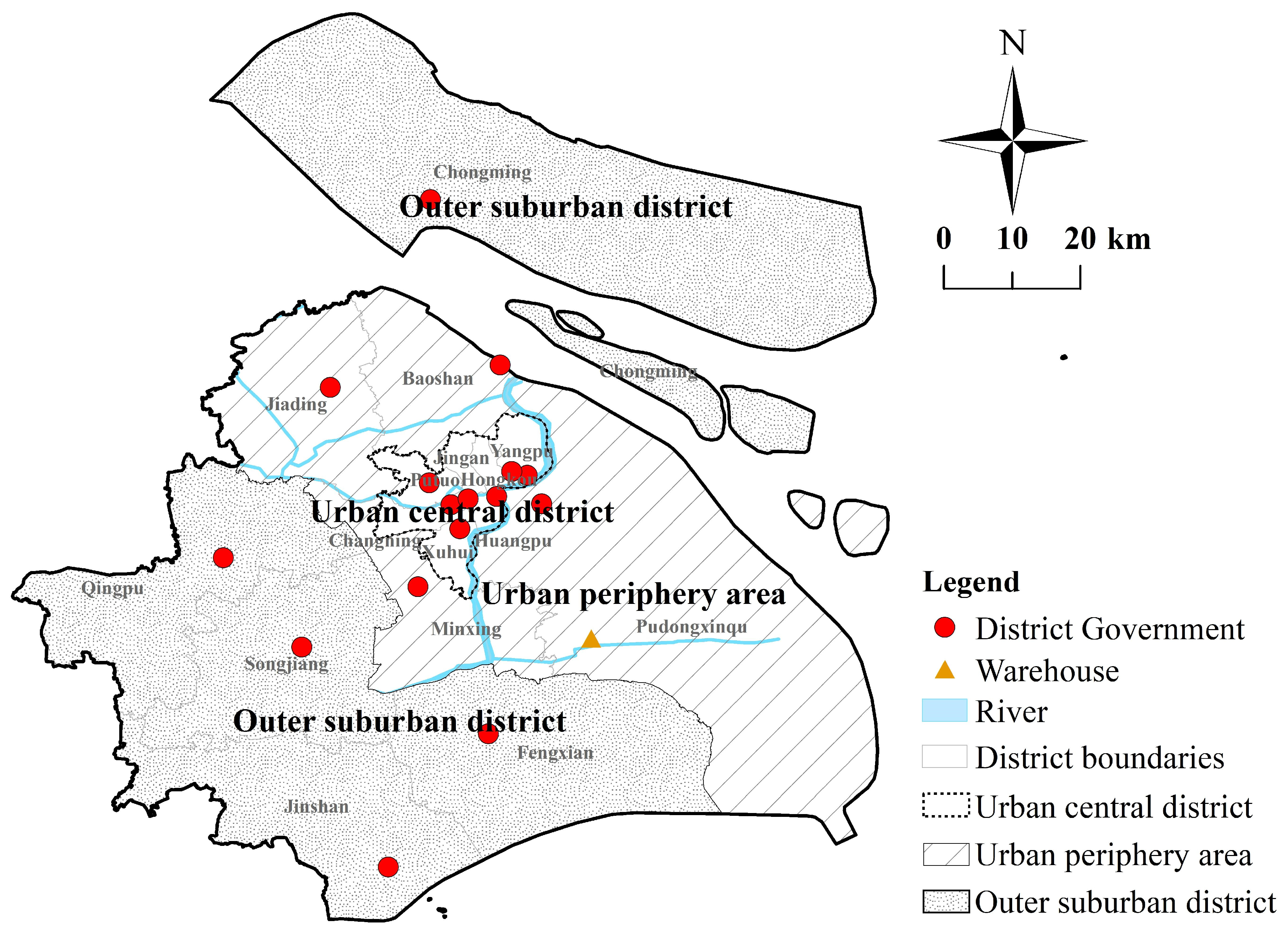
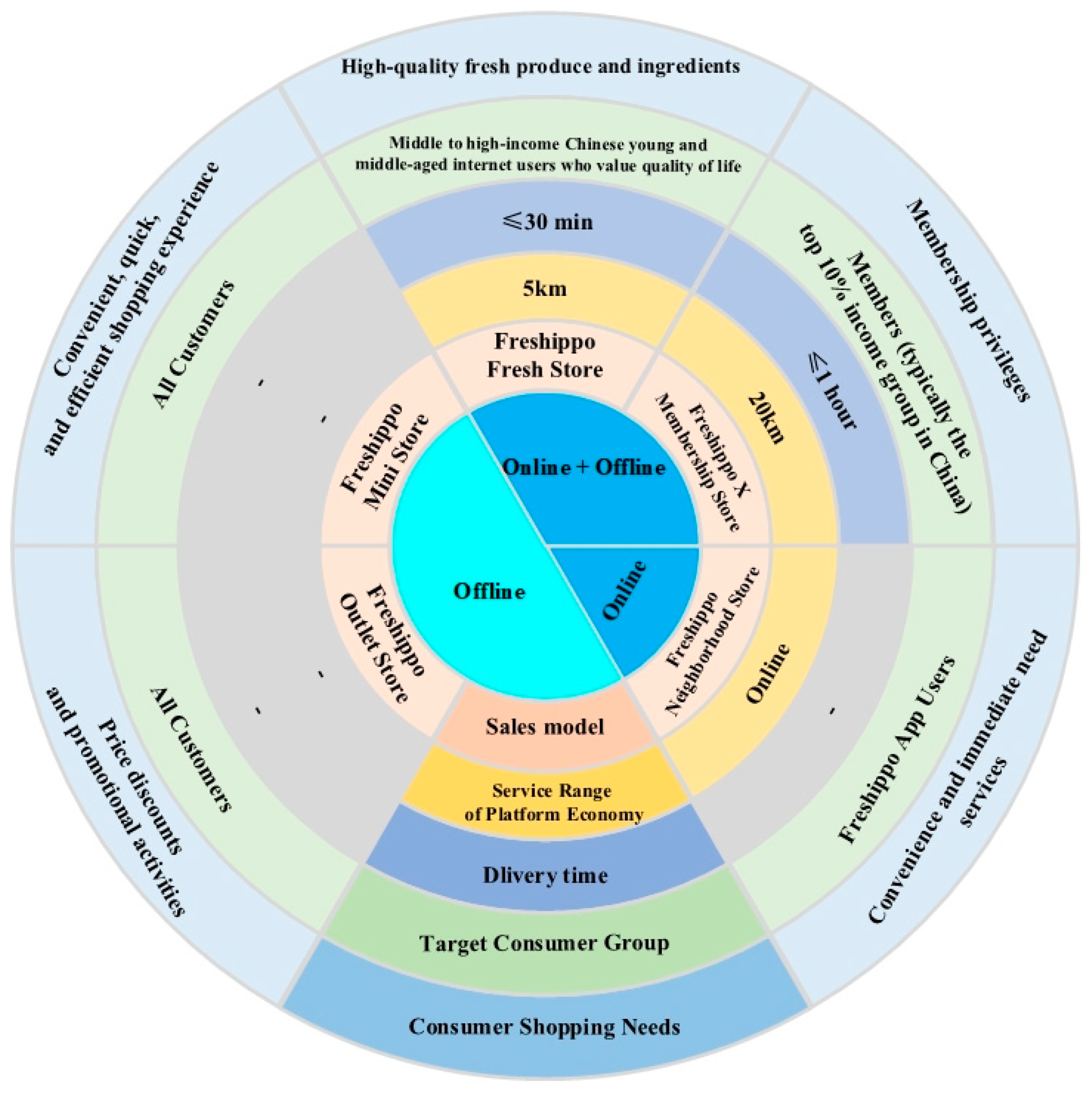
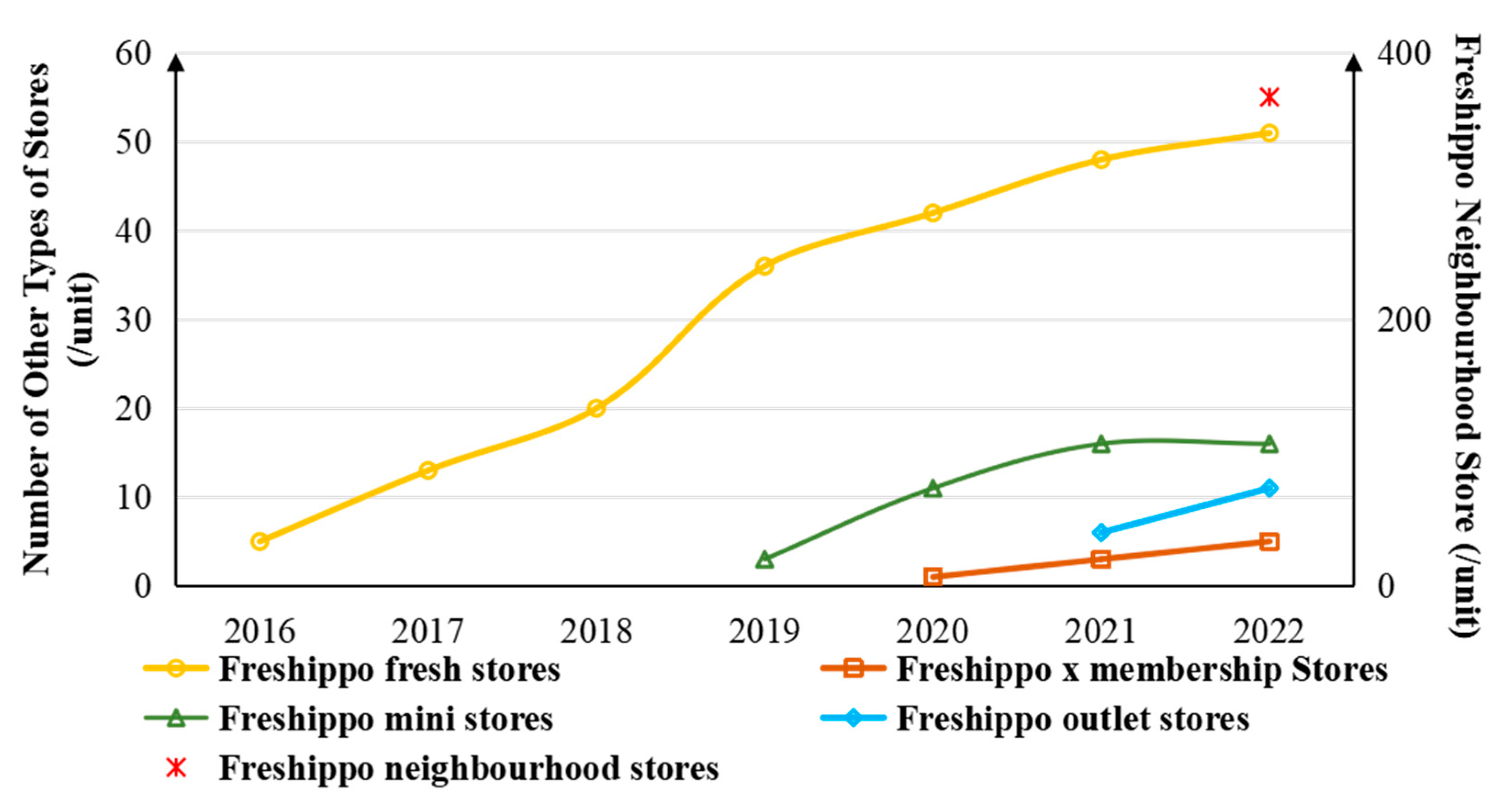




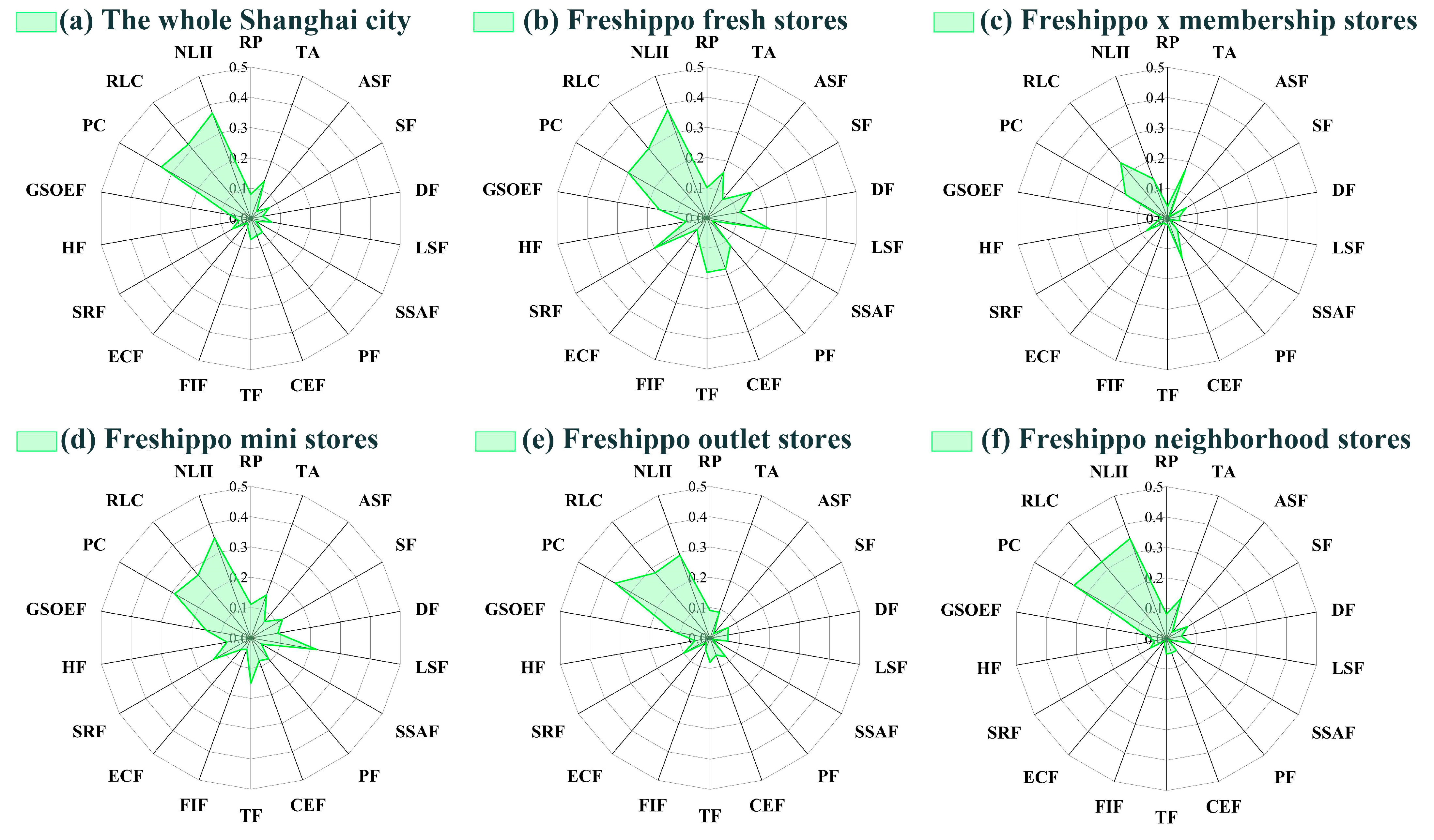

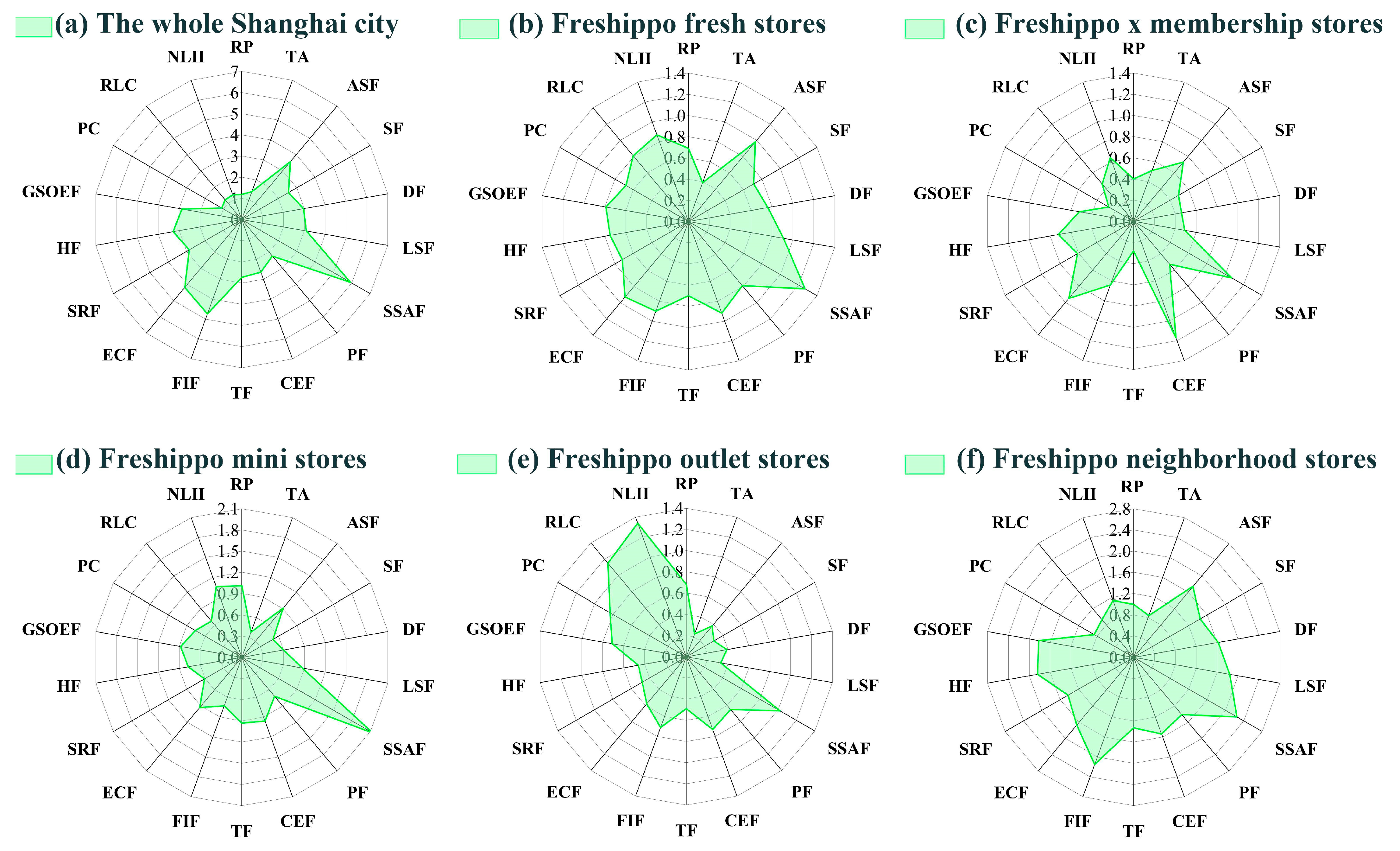
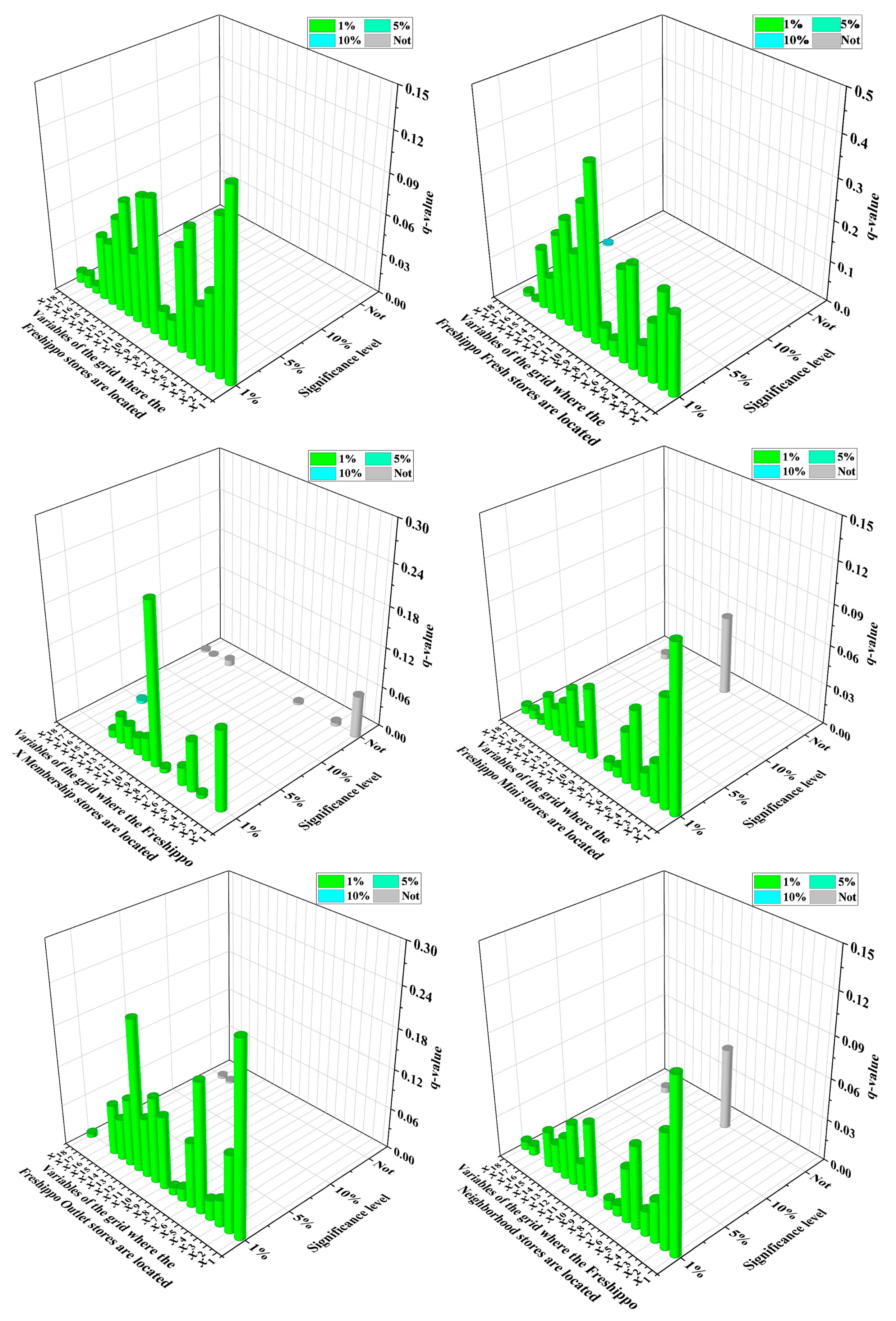
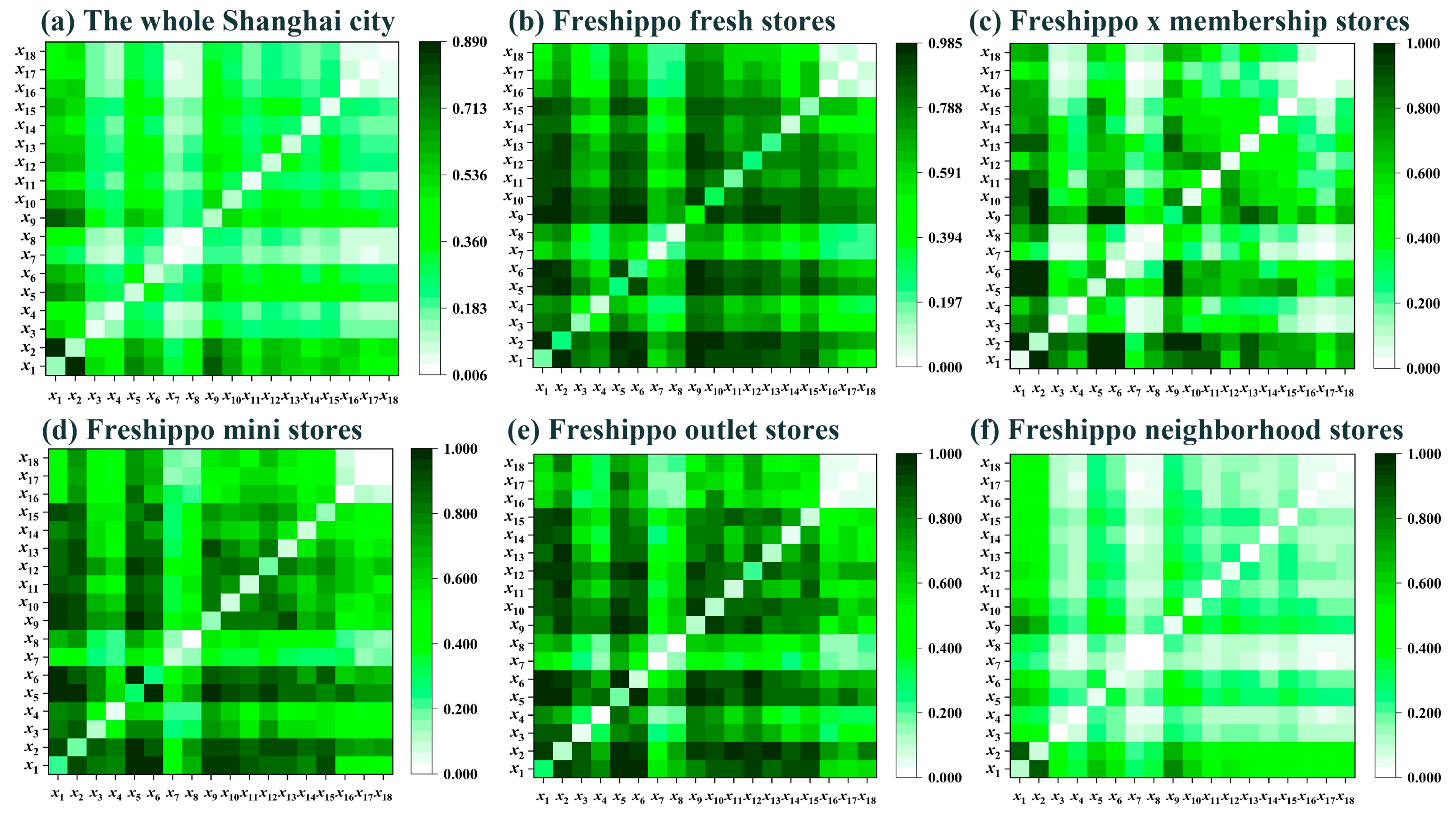
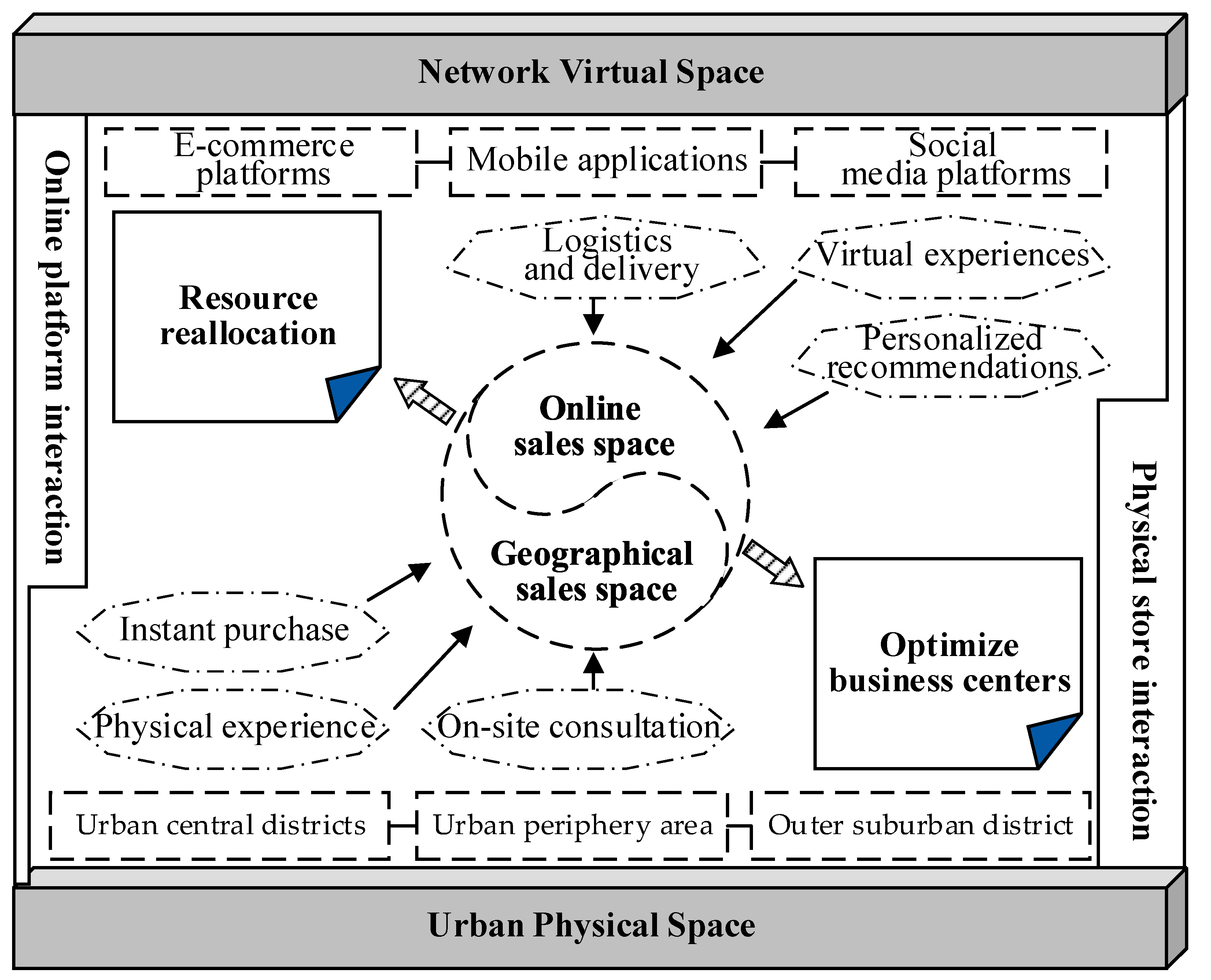
| Store Type | Number of Geographical Units in Aggregated State | |||
|---|---|---|---|---|
| “High–High” Aggregation | “Low–Low” Aggregation | “Low–High” Aggregation | “High–Low” Aggregation | |
| Freshippo fresh store | 29 | 0 | 57 | 1 |
| Freshippo x membership store | 0 | 5 | 10 | 2 |
| Freshippo mini store | 0 | 2 | 12 | 3 |
| Freshippo outlet store | 0 | 3 | 6 | 3 |
| Freshippo neighborhood store | 19 | 97 | 5 | 6 |
| Type | Urban Space Coverage | Residential Community Quantity Coverage |
|---|---|---|
| Freshippo fresh store | 13.23% | 67.87% |
| Freshippo x membership store | 28.48% | 82.31% |
| Freshippo neighborhood store | 4.27% | 7.01% |
| Service range union | 31.92% | 88.02% |
| Variable Name | Abbreviation | Number | Explanation | Unit |
|---|---|---|---|---|
| Rent price | RP | x1 | Average daily rent per square meter of street-facing and underground shops within the grid | Yuan/day/m2 |
| Transport accessibility | TA | x2 | Road density per unit area within the grid | Yuan/day/m2 |
| Accommodation service facilities | ASFs | x3 | Density of accommodation service facilities per unit area within the grid | Number/km2 |
| Shopping facilities | SFs | x4 | Density of shopping facilities per unit area within the grid | Number/km2 |
| Dining facilities | DFs | x5 | Density of dining facilities per unit area within the grid | Number/km2 |
| Lifestyle service facilities | LSFs | x6 | Density of lifestyle service facilities per unit area within the grid | Number/km2 |
| Scenic spots and attractions facilities | SSAFs | x7 | Density of scenic spots and attractions per unit area within the grid | Number/km2 |
| Public facilities | PFs | x8 | Density of public facilities per unit area within the grid | Number/km2 |
| Companies and enterprises facilities | CEFs | x9 | Density of companies and enterprises per unit area within the grid | Number/km2 |
| Transportation facilities | TFs | x10 | Density of transportation facilities per unit area within the grid | Number/km2 |
| Financial and insurance facilities | FIFs | x11 | Density of financial and insurance organizations per unit area within the grid | Number/km2 |
| Educational and cultural facilities | ECFs | x12 | Density of educational and cultural facilities per unit area within the grid | Number/km2 |
| Sports and recreational facilities | SRFs | x13 | Density of sports and recreational facilities per unit area within the grid | Number/km2 |
| Healthcare facilities | HFs | x14 | Density of healthcare facilities per unit area within the grid | Number/km2 |
| Government agencies and social organizations facilities | GSOEFs | x15 | Density of government agencies and social organizations per unit area within the grid | Number/km2 |
| Population count | PC | x16 | Density of permanent residents per unit area within the grid | Ten thousand people/km2 |
| Residential land count | RLC | x17 | Density of residential land per unit area within the grid | /km2 |
| Nighttime light intensity index | NLII | x18 | Nighttime light remote sensing value per unit area within the grid | /km2 |
Disclaimer/Publisher’s Note: The statements, opinions and data contained in all publications are solely those of the individual author(s) and contributor(s) and not of MDPI and/or the editor(s). MDPI and/or the editor(s) disclaim responsibility for any injury to people or property resulting from any ideas, methods, instructions or products referred to in the content. |
© 2024 by the authors. Licensee MDPI, Basel, Switzerland. This article is an open access article distributed under the terms and conditions of the Creative Commons Attribution (CC BY) license (https://creativecommons.org/licenses/by/4.0/).
Share and Cite
Zhang, E.; Zhou, Y.; Chen, G.; Wang, G. Classified Spatial Clustering and Influencing Factors of New Retail Stores: A Case Study of Freshippo in Shanghai. Sustainability 2024, 16, 6643. https://doi.org/10.3390/su16156643
Zhang E, Zhou Y, Chen G, Wang G. Classified Spatial Clustering and Influencing Factors of New Retail Stores: A Case Study of Freshippo in Shanghai. Sustainability. 2024; 16(15):6643. https://doi.org/10.3390/su16156643
Chicago/Turabian StyleZhang, Ershen, Yajuan Zhou, Guojun Chen, and Guoen Wang. 2024. "Classified Spatial Clustering and Influencing Factors of New Retail Stores: A Case Study of Freshippo in Shanghai" Sustainability 16, no. 15: 6643. https://doi.org/10.3390/su16156643







